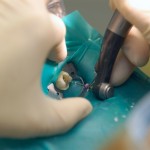
Root canal treatment is a commonly undertaken procedure to prevent or eliminate apical periodontitis of endodontic origin. Previous reviews have estimated average success rates of between 68% and 85% at 1 year (Ng et al., 2007, 2008).
The main aim of this review was to assess the outcomes of primary root canal treatment (RoCT) in studies published since 2003. A secondary outcome was to assess characteristics affecting outcomes.
Methods
A protocol for the review was registered in PROSPERO and searches conducted in the Cochrane clinical trials register, PubMed, Embase, CINHAL and the Web of Science databases with no restrictions on language. This was supplemented by hand searches conducted in the journals, Journal of Endodontics, International Endodontic Journal, Oral Surgery, Oral Medicine, Oral Pathology and Oral Radiology, and Dental Traumatology. Randomized control trials (RCT), cohort studies, retrospective observational studies with at least 12 months follow-up providing data to calculate success rates were considered. Clinical success was defined as the absence of clinical symptoms. Radiographic success was assessed using ‘strict’ (absence of apical radiolucency at follow-up) or ‘loose’ criteria (reduction in the size of apical radiolucency at follow-up). Two reviewers independently screened and selected studies and extracted data with any conflicts being resolved by a third reviewer. Individual study quality was assessed using the Grading of Recommendations, Assessment, Development and Evaluation (GRADE) approach. Weighted, pooled success rates were calculated using random effects meta-analysis.
Results
- 42 studies (15 RCTs, 14 prospective cohorts and 13 retrospective studies) were included.
- Sample sizes ranged from 27 to 1376 teeth.
- 38 studies assessed outcomes clinically and radiographically, 4 studies used CBCT.
- Length of follow up ranged from 12 months to 19 years.
- Success rates ranged from 73.3% to 100% using ‘loose’ criteria and from 29.8% to 97.3% when using ‘strict’ criteria.
- Meta-analyses showed that the weighted pooled radiographic success rates using
- ‘loose’ criteria = 92.6% (95%CI: 90.5% to 94.8%) [21 studies].
- ‘strict’ criteria = 82% (95%CI: 79.3% to 84.4%) [39 studies].
- 11 studies provided data on the presence of pre-operative periapical lesion. The odds of success were lower for teeth pre-operative periapical lesions compared with teeth without pre-operative periapical lesions OR= 2.75 (95% CI: 1.73 to 4.41).
- No statistically significant difference in outcomes across studies was seen by method of instrumentation (hand vs. rotary).
- Studies collected data on the type of restoration placed at the completion of treatment however reporting variation precluded analyses of their influence on outcomes
Conclusion
The authors concluded: –
…outcomes of primary root canal therapy remain high and endodontic treatment is, overall, a re- liable and successful method of preserving the natural dentition no matter the outcome criteria used. Biological factors, such as the presence of a pre-operative periapical radiolucency, continue to be the most significant factors influencing the outcome of primary root canal therapy. Additionally, the findings of this research suggest that technological advancements in root canal instrumentation, such as nickel-titanium rotary instruments, aimed at increasing the efficiency and reproducibility of endodontic treatment, have not impacted treatment success rates. The results of the quality assessment highlight that randomised control trials are an infrequently utilized study design in the outcome assessment of primary root canal therapy and thus the level of evidence for these studies remain low, by GRADE standards.
Comments
A protocol for the review was registered on the PROSPERO database and good range of databases and journals were searched. A small number of non-English papers were excluded. Forty-two studies were included of which 15 were RCTs the remainder were either prospective or retrospective cohorts which are at greater risk of selection bias. There is also concern of the proportion of dropouts (attrition bias) in some of the studies and as the authors point out that 18 of the studies excluded teeth from analysis that were extracted or required further endodontic treatment. Consequently, the outcome reported outcomes in this review are very likely to be overestimates. In addition to the radiographic success rates reported the authors looked at a number of other variables including, length of follow up operator experience, and a number of clinical characteristics. However, the variation in reporting means that these estimates should be viewed with caution. In the reviews abstract the authors suggest that outcomes are improving over time however the 95% confidence intervals for pooled success rates using the ‘loose’ criteria for 2003-2010 of 90.9% ( 95%CI: 86.7% to 95.0%) and 93.1% (95%CI: 90.7% to 95.5%) for 2011- 2020 overlap.
Links
Primary Paper
Burns LE, Kim J, Wu Y, Alzwaideh R, McGowan R, Sigurdsson A. Outcomes of primary root canal therapy: An updated systematic review of longitudinal clinical studies published between 2003 and 2020. Int Endod J. 2022 Mar 25. doi: 10.1111/iej.13736. Epub ahead of print. PMID: 35334111.
Other references
Ng YL, Mann V, Rahbaran S, Lewsey J, Gulabivala K. Outcome of primary root canal treatment: systematic review of the literature – part 1. Effects of study characteristics on probability of success. Int Endod J. 2007 Dec;40(12):921-39. doi: 10.1111/j.1365-2591.2007.01322.x. Epub 2007 Oct 10. PMID: 17931389.
Ng YL, Mann V, Rahbaran S, Lewsey J, Gulabivala K. Outcome of primary root canal treatment: systematic review of the literature — Part 2. Influence of clinical factors. Int Endod J. 2008 Jan;41(1):6-31. doi: 10.1111/j.1365-2591.2007.01323.x. Epub 2007 Oct 10. PMID: 17931388.
